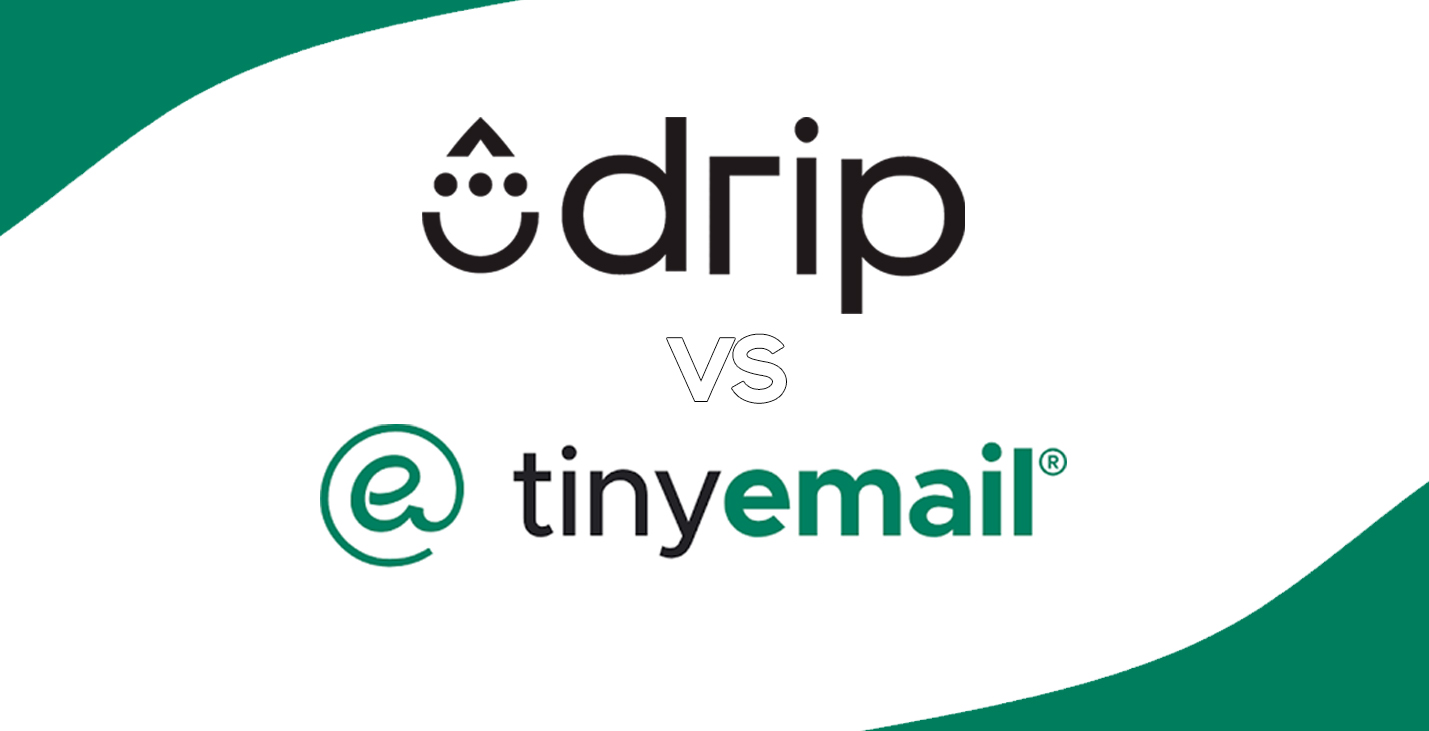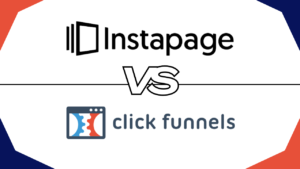Choosing the right email marketing tool can significantly impact your business’s growth. This is precisely why the “Drip vs TinyEmail” debate is essential for marketers and business owners. Both platforms bring distinct features to the table and are designed to meet varying business requirements. In this blog post, we’ll thoroughly compare Drip vs TinyEmail, delving into their functionalities, pricing structures, user experiences, and much more. Our goal is to equip you with the necessary insights to make a well-informed choice. Whether you’re spearheading a startup, navigating the marketing world, or scaling a business, understanding these platforms’ capabilities is key to maximizing your email marketing efforts. Join us as we unravel the strengths and offerings of Drip vs TinyEmail.
Table of Contents
Quick Comparison: Drip and TinyEmail

In the dynamic world of email marketing, two names often come up in discussions among digital marketers: Drip and TinyEmail. As we dive into the comparison of these two platforms in this “Drip vs Tinyemail” analysis, it’s important to first understand what each offers.
Drip: A Comprehensive Email Marketing Solution
Drip positions itself as a powerful, feature-rich email marketing platform designed for eCommerce businesses. It stands out for its advanced automation capabilities, deep integration with eCommerce platforms, and comprehensive customer data insights. Drip enables users to create personalized and targeted email campaigns that are not just about sending emails but about creating a journey for each customer. With its robust analytics, Drip offers a clear view of how email campaigns are performing, making it a go-to tool for businesses seeking to scale up their online marketing efforts.
TinyEmail: Simplicity and Efficiency
On the other side, TinyEmail is renowned for its simplicity and user-friendly approach. This platform is ideal for small to medium-sized businesses looking for an efficient and straightforward email marketing tool. TinyEmail’s strength lies in its ease of use, allowing users to quickly set up campaigns without a steep learning curve. Although it might not offer as in-depth analytics as Drip, it provides all the essential features needed for effective email marketing, such as customizable templates, basic automation, and decent segmentation capabilities.
Both Drip and TinyEmail offer unique advantages and cater to different needs in the email marketing domain. In this “drip vs tinyemail” comparison, our goal is to provide you with a clear picture of what each platform offers, helping you decide which one aligns best with your business goals.
Pricing and Plans: Comparing Costs
Drip’s pricing is primarily based on the number of contacts in your email list. This means the more contacts you have, the higher the price. However, what stands out with Drip is its scalability. As your business grows and your contact list expands, Drip’s advanced features become more valuable, making it a solid investment for growing eCommerce businesses. They offer a range of plans, starting from a basic plan suitable for small businesses with fewer contacts, up to more advanced plans designed for large-scale operations.
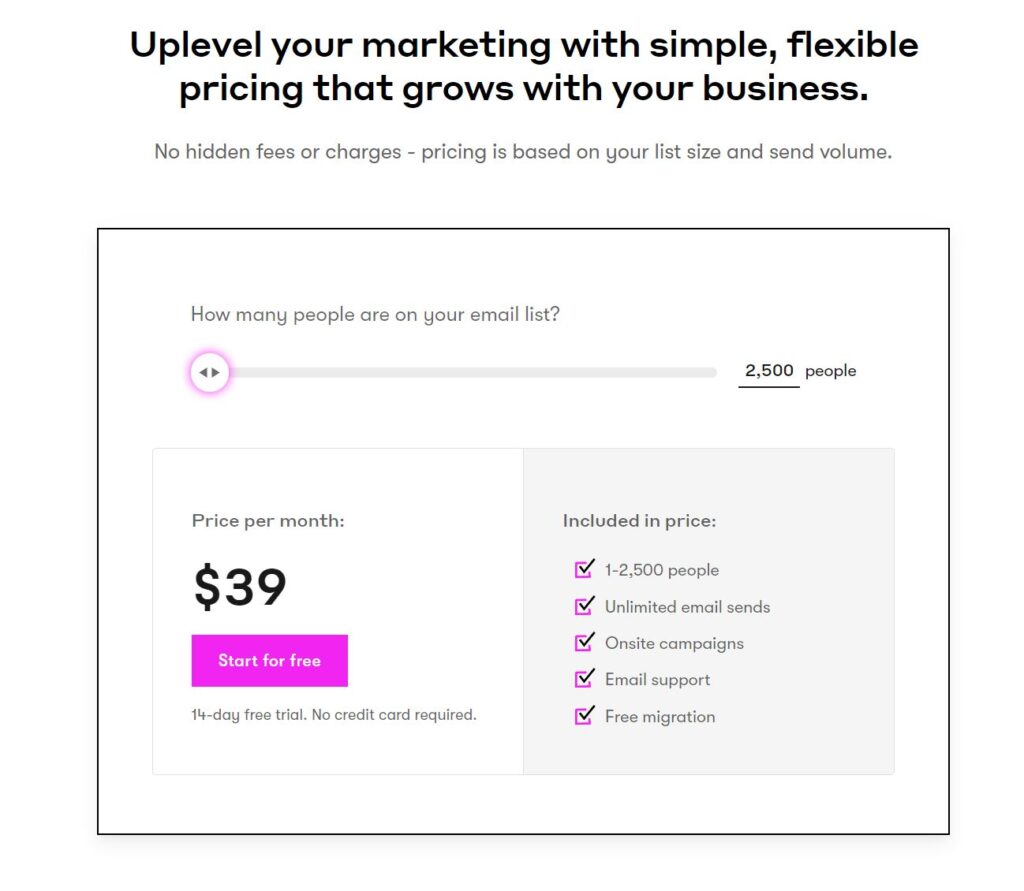
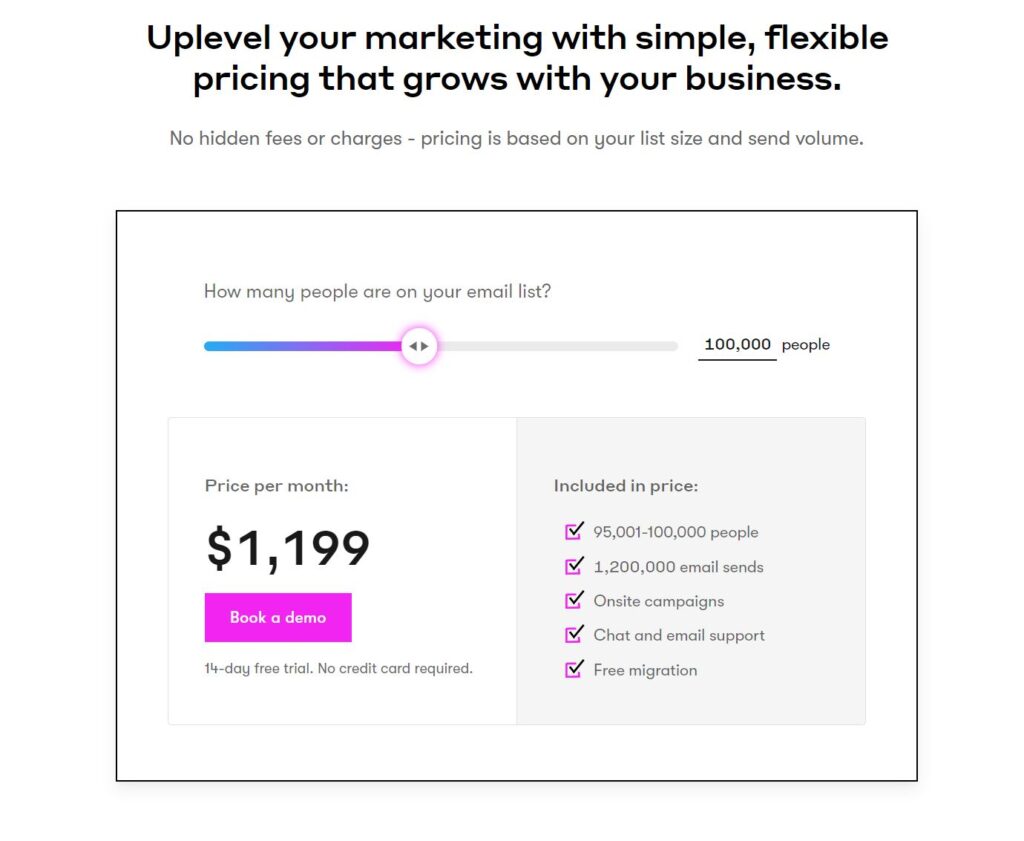
TinyEmail: Straightforward and Affordable
TinyEmail, in contrast, is known for its more straightforward and affordable pricing structure. They offer a simpler set of plans, which is often a relief for small to medium-sized businesses that need essential email marketing features without the complexity of tiered pricing. Their plans usually include all available features, differing mainly in the volume of emails sent per month. This simplicity makes TinyEmail an attractive option for startups and smaller businesses looking for cost-effectiveness and ease of budgeting.
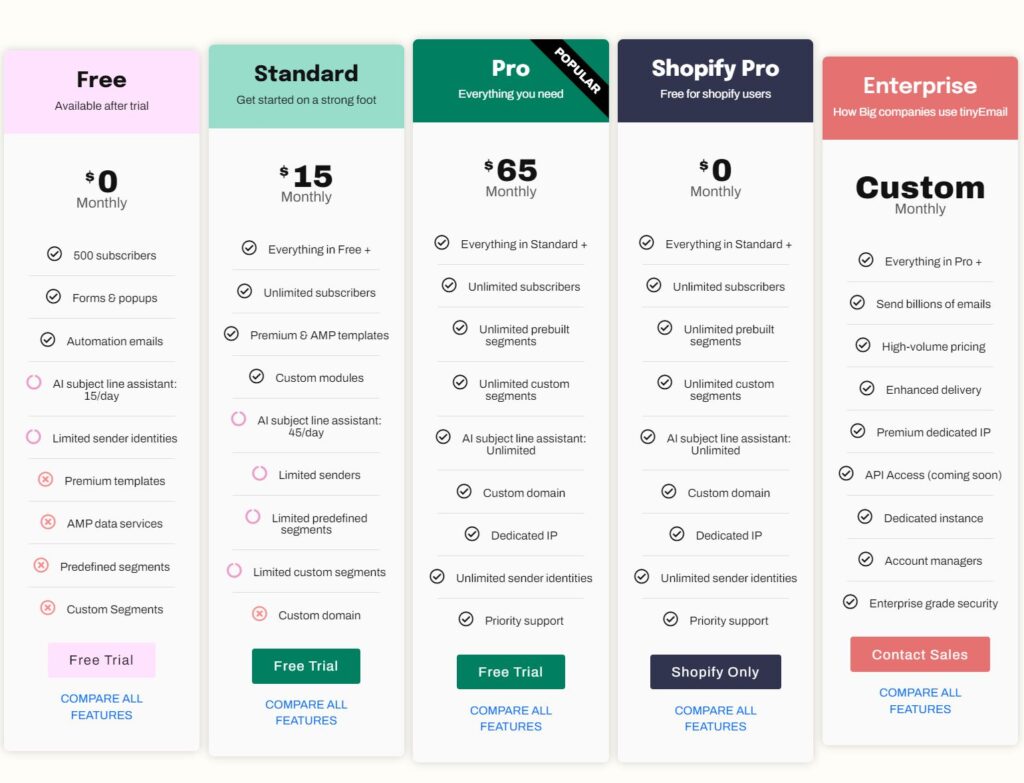
Value for Money and Business Suitability
When it comes to value for money, Drip offers a comprehensive set of features that justify its pricing, especially for eCommerce businesses that can leverage its advanced automation and segmentation capabilities. On the other hand, TinyEmail provides excellent value for smaller businesses that need an effective, no-frills email marketing solution at an affordable price.
Features of Both Platforms: Drip vs TinyEmail

When comparing the core features of Drip and TinyEmail in our “Drip vs Tinyemail” analysis, it’s clear that while both platforms serve the same primary function of email marketing, they offer different sets of features catering to varied business needs.
Drip: Advanced Features for the Modern Marketer
Drip is renowned for its comprehensive set of advanced features, which are particularly beneficial for eCommerce businesses. Some of its key features include:
- Email Automation: Drip’s sophisticated automation tools allow for the creation of complex, trigger-based email sequences.
- Segmentation and Personalization: Offers advanced segmentation options based on customer behavior, enabling highly personalized email campaigns.
- Third-Party Integrations: Extensive integrations with numerous eCommerce platforms, CRM systems, and other marketing tools.
- Analytics and Reporting: Detailed analytics provide insights into campaign performance, customer behavior, and more.
- Multichannel Marketing: Supports not just email but also SMS and social media integrations, offering a broader reach.
TinyEmail: Simplified Email Marketing for Efficiency
TinyEmail, on the other hand, focuses on providing a streamlined and user-friendly experience with its core features, which include:
- Easy-to-Use Email Builder: Offers a drag-and-drop email editor for quick and easy creation of attractive emails.
- Basic Automation: While not as advanced as Drip, TinyEmail provides essential automation capabilities suitable for standard email marketing needs.
- List Management: Simple yet effective tools for managing and segmenting your email list.
- Pre-designed Templates: A variety of customizable templates to quickly start email campaigns.
- Basic Analytics: Provides essential analytics to track the performance of email campaigns.
Drip offers a range of advanced features tailored for businesses looking for comprehensive, data-driven email marketing solutions. TinyEmail, with its streamlined feature set, caters to those seeking simplicity and efficiency in their email marketing endeavors.
Customer Support and Community
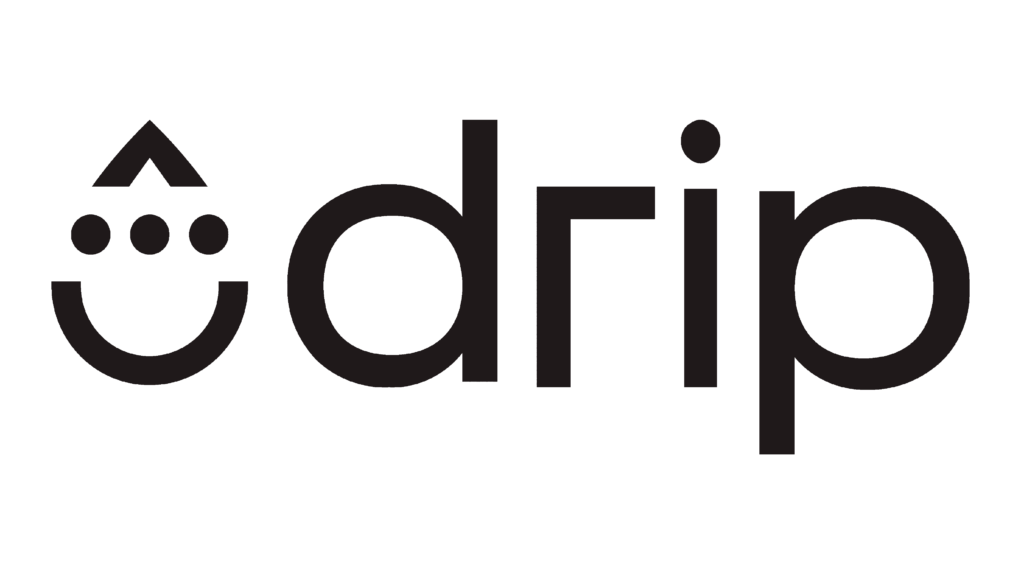
Drip takes customer support seriously, offering multiple channels through which users can seek assistance. Key aspects of Drip’s customer support include:
| Live Chat Support | ✓ |
| Email Support | ✓ |
| Knowledge Base | ✓ |
| Community Forums | ✓ |
| Webinars and Training | ✓ |
The quality of Drip’s support is generally rated highly, with users appreciating the responsiveness and expertise of the support team. However, some users might find the lack of phone support a limitation, especially those who prefer direct verbal communication.

TinyEmail, while smaller in scale compared to Drip, offers efficient and personalized customer support. Their support framework includes:
| Email Support | ✓ |
| Help Center | ✓ |
| Direct Contact Options | ✓ |
| Community Engagement | ✓ |
TinyEmail’s customer support is often praised for its personalized approach. The smaller scale of their operation allows for more individualized attention, though the lack of live chat and phone support might be a drawback for some users.
Security and Reliability

Photo by Franck
Understanding the security and reliability of both platforms is crucial, as they play a pivotal role in the successful operation of email marketing campaigns.
Drip takes security seriously, implementing robust measures to protect user data and ensure consistent service reliability. Key aspects include:
- Data Encryption: Utilizes strong encryption protocols to secure data both in transit and at rest.
- Regular Backups: Ensures data integrity with regular, systematic backups.
- Continuous Monitoring: Implements 24/7 monitoring to swiftly detect and address any security threats.
- Compliance with Regulations: Adheres to GDPR and other data protection regulations, safeguarding user privacy.
Security and Reliability in TinyEmail
TinyEmail also prioritizes security and reliability, albeit with a focus on simplicity. Its key features include:
- Data Protection: Emphasizes the protection of customer data with effective encryption methods.
- Simplified Data Management: Offers straightforward tools for managing and safeguarding user data.
- Reliable Infrastructure: Maintains a dependable service infrastructure for consistent email delivery.
- Customer Support for Security Issues: Provides dedicated support for any security-related concerns.
While both Drip vs TinyEmail exhibit a strong commitment to security and reliability, Drip tends to have more advanced and detailed protocols in place, suitable for businesses with extensive data and higher security needs. TinyEmail, while maintaining essential security standards, offers a more streamlined approach, appropriate for smaller businesses that prioritize ease of use along with security.
Alternatives to Drip and TinyEmail
While “Drip vs TinyEmail” covers a significant portion of the email marketing landscape, there are other noteworthy alternatives in the market that might better suit different business needs. Here’s a look at some popular alternatives:
- Overview: ActiveCampaign is distinguished by its advanced automation and CRM integration, making it a powerful tool for personalized marketing.
- Ideal for: Businesses seeking a sophisticated email marketing solution with strong CRM and automation capabilities.
- Key Features: Email segmentation, site tracking, SMS marketing, and a built-in CRM system.
To learn more about ActiveCampaign, we recommend that you read this ActiveCampaign vs TinyEmail
- Overview: ConvertKit is tailored towards creators and bloggers, offering a straightforward approach to email marketing with an emphasis on building and managing email lists.
- Ideal for: Bloggers, creators, and small businesses looking for an easy-to-use platform with efficient list management.
- Key Features: Email automation, customizable forms, landing pages, and audience segmentation.
- Overview: Primarily an online course platform, Thinkific also offers tools for email marketing, particularly useful for educators and course creators.
- Ideal for: Educators, trainers, and anyone creating and selling online courses who also need integrated marketing tools.
- Key Features: Course creation tools, integrated email marketing for course promotion, and student engagement tools.
- Overview: ClickFunnels is a comprehensive sales funnel builder that includes email marketing features to nurture leads and boost sales.
- Ideal for: Businesses focused on creating sales funnels and looking for an all-in-one platform for marketing, sales, and lead generation.
- Key Features: Drag-and-drop funnel builder, email automation, landing pages, and webinar hosting.
To learn more about Clickfunnels, we recommend that you read this Clickfunnels Review
- Overview: MailerLite is known for its simplicity and affordability, offering essential email marketing features with an intuitive interface.
- Ideal for: Small to medium-sized businesses and startups looking for an easy-to-use, cost-effective email marketing tool.
- Key Features: Drag-and-drop email editor, automation, landing pages, and detailed analytics.
FAQs Related to Drip and TinyEmail
What is the main difference between Drip and TinyEmail?
- The main difference lies in their target audience and feature set. Drip offers advanced automation, segmentation, and integration features, making it ideal for medium to large businesses or those with complex email marketing needs. TinyEmail, conversely, is designed for simplicity and ease of use, catering primarily to small businesses and startups looking for basic, efficient email marketing tools.
Can I integrate Drip and TinyEmail with other platforms?
- Yes, both offer integration capabilities. Drip provides extensive integration options with various eCommerce platforms, CRM systems, and other marketing tools. TinyEmail, while offering fewer integrations, covers essential services and platforms commonly used by small businesses.
How do pricing models for Drip and TinyEmail differ?
- Drip’s pricing is based on the number of contacts in your list, scaling up as your list grows. TinyEmail, on the other hand, offers a more straightforward and generally more affordable pricing structure, making it a cost-effective choice for smaller businesses.
Which platform offers better analytics and reporting?
- Drip offers more in-depth analytics and reporting features, providing detailed insights into campaign performance and customer behavior. TinyEmail provides basic analytics, sufficient for smaller scale campaigns and businesses that need straightforward reporting.
Is customer support readily available for both Drip and TinyEmail?
- Yes, both platforms provide customer support. Drip offers multiple support channels, including live chat and email, alongside a comprehensive knowledge base. TinyEmail focuses on email support and has a curated help center for self-service assistance.
Are Drip and TinyEmail suitable for beginners in email marketing?
- TinyEmail is more suited for beginners due to its simplicity and user-friendly interface. Drip, while offering advanced features, might have a steeper learning curve but is still manageable with the help of its resources and support.
Conclusion
Navigating through the intricate landscape of email marketing tools can be challenging, but our in-depth Drip vs Tinyemail comparison aims to simplify this decision for you. Drip emerges as a powerhouse of advanced features, suitable for businesses seeking a comprehensive, data-driven approach to email marketing. Its capability to handle complex automation and provide detailed analytics makes it a standout choice for larger businesses or those with specific needs in segmentation and integration.
TinyEmail, with its straightforward approach and user-friendly interface, is a beacon for small businesses and startups. It strips down the complexities of email marketing to the essentials, offering a budget-friendly and efficient solution without overwhelming users with advanced features they might not need.
Ultimately, the decision between Drip and TinyEmail boils down to your specific business needs, size, and the level of sophistication required in your marketing efforts. Consider not just the present requirements of your business but also anticipate future growth and how each platform can scale to meet those evolving needs.
We hope this comparison has provided you with valuable insights and clarity, guiding you toward making an informed decision that best suits your business’s email marketing journey. Remember, the right tool is the one that aligns seamlessly with your marketing strategy, helping you to effectively reach your audience and achieve your business goals.
Thanks for Reading our Blog about Drip vs TinyEmail, if you’re interested be sure to check out our other blogs!

